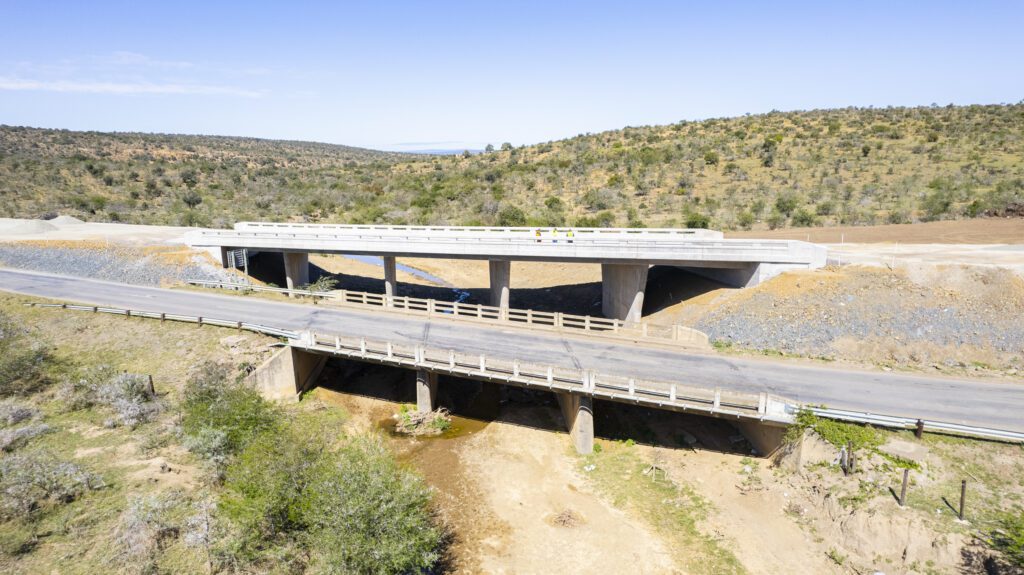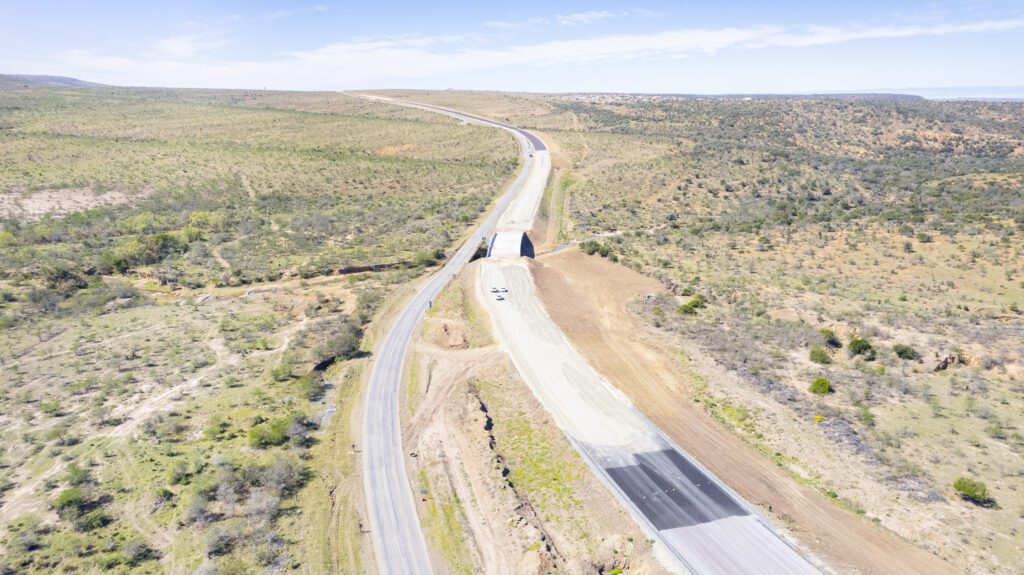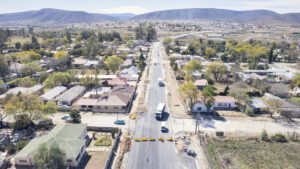Businesses and travellers alike are to benefit from the exciting upgrade of the R63 road from Fort Beaufort to Alice in the Eastern Cape, currently being carried out by Rumdel Construction Cape.
According to Sanral, who commissioned the project, the new road will make for safer and smoother travel while reducing congestion. The work includes extensive use of concrete for structures such as bridges and culverts, for which AfriSam is providing its High Strength Cement. The project’s scope covers the 23 km Section 13 of the R63, comprising 2.6 km of urban road running through the town ofFort Beaufort and 20.4 km of rural road. Alistair De Lacy, project manager at Rumdel Construction Cape, says mobilisation of staff and equipment took place from July 2020, allowing work to begin in October 2020. “We partnered with AfriSam for the cement for all structural elements of this contract, using mainly their High Strength 52.5N Cement,” says De Lacy. “This was suitable for the three new bridges, two bridge widenings, 12 cast-in-situ box culverts and V-drains included in our scope of work.” In line with the local procurement focus, a local readymix supplier was selected, who used AfriSam’s 52.5N product for the bridge pours and other applications. Some 4 100 m3 of durability concrete was poured for the bridges, 2 600 m3 for the culverts and 7 000 m3 for side drains and channels. AfriSam is also supplying its specialist road stabilising cement, Roadstab Cement, of which 1 300 tonnes are going into bypasses and 4 500 tonnes for the main works. “We have had a seamless relationship with AfriSam through close communication at all times regarding supply,” he says. “They have been very helpful in ensuring that our programme requirements are met.”
Campbell Street
On the urban side of the contract, the work focused on rehabilitating Fort Beaufort’s main road, Campbell Street. This task went well beyond road work to include the widening of bridges and the rehabilitation of drainage, sewer and water networks. “We reconstructed a 650 mm pavement with a 40 mm asphalt overlay, after replacing the sewer and water networks,” he says. “Adding to the complexity of this task was marrying the new networks to the existing systems, which date back many years.” Significantly, as per Sanral contractual requirements, Rumdel prioritised the engagement of ‘targeted enterprises’ – which are historically disadvantaged businesses – in conducting this work. With a budget from Sanral, Rumdel was able to train, mentor and closely supervise these businesses to achieve the required high standard of results. He notes that the company has achieved an unusually high number of targeted enterprises on the project as a whole. By August 2022, over 70 of these businesses have been involved, and this number is expected to rise to around 90 by the project’s close.
Minimising disruption
Among the challenges was to minimise the disruption to local businesses and residents in Fort Beaufort, as well as traffic passing through the town en route to other destinations. A particular concern was to facilitate the movement of agricultural transport trucks, as the citrus picking season occurred during the roadworks. “It was important to communicate constantly with residents and other stakeholders, making sure that everyone knew what our work programme was and how we were planning to accommodate them,” he says. “Our efforts to reduce disruption were supported by Sanral, who agreed that we employ a revised layer works solution to put the main road back into service much quicker.” To do this, the G1 base course was stabilised with an anionic bitumen emulsion, introduced with the on-site Wirtgen recycler linked to a bitumen distributor feeding at 38 litres per cubic metre with 1% cement. This allowed traffic to resume the day after installation, rather than waiting the seven to eight days normally required.On either side of town, the bridges over the Kat River and the Brak River have been widened to ease traffic flow and allow for safer pedestrian access. Work began on the Kat River bridge in November 2020 and was completed in July 2022, adding 2 m to each side. The smaller and lower Brak River bridge was widened by 3 m on either side between February and September 2022.
The final aspects of the work to Campbell Street, such as the streetlights and sidewalks, were expected to be completed by October 2022, with only road marking and signage outstanding.
Safe, efficient road
To improve the R63 route between Fort Beaufort and Alice, the road design has included extensive vertical and horizontal alignment. This is to meet the Sanral imperative of replacing gravel shoulders, sharp curves and steep slopes with wider paved shoulders, flatter geometry, gentler curves and longer sight distance. There will also be climbing lanes for trucks, to allow safer passing and freer flow of traffic. A community development programme running alongside the road contract will ensure that the new intersections better serve the nearby communities. “The existing road was only about 6.3 m – which we are widening to 13.4 m,” says De Lacy. “We are putting formal intersections in place and widening the road considerably at these points; some intersections will also be moved to improve sight distance.” He explains that – from a build programme perspective – the 12 box culverts were the most important elements of the job. In the context of the road realignment, there were fills of 12-15 m with a requirement for a five-month settlement period after fill construction. “The programme therefore had to be ‘front-loaded’ with these culverts, to ensure there was sufficient time for the fill to settle,” he says. “This allowed all 12 to be completed by November 2021 – by getting an early start and having the necessary aggregate and cement in place to allow for approval of the concrete mix design during the mobilisation stage.”
Building bridges
Realigning the new road has required the building of a completely new bridge over the Mxelo River. This 65 m long five-span structure will stand 8 m above the riverbed, taking the place of the old bridge to be demolished. Two other road-over-rail bridges are also part of the project. The three-span Kwatinidubu rail bridge is 48 m long, while the Kwezana bridge is 52 m long. “All three structures were designed with monolithic decks, so there are no joints in the bridges,” he says. “This required a 32-hour continuous concrete pour for the Mxelo River bridge, while the pours for the two rail bridge decks were around 24 hours each.” He emphasises how the extensive vertical alignment changes led to considerable challenges with ground hardness. This required the blasting of around 480 000 m3 of hard material to achieve the necessary design levels. “It is of course necessary to continue to accommodate traffic on the route while we build the new road, so there needs to be a link-up between old and new roads despite the vertical realignments,” he explains. “This meant that in some areas the temporary road would be too narrow for traffic.” This was solved by temporarily widening the permanent works to accommodate two-way traffic, resulting in much less disruption to the local community. Blasting was also not permitted near completed roadworks, as the blast could cause an uplift effect on existing layers. The solution here was to extend the bypasses, which has led to the construction of 10.4 km of full-width bypass and 3 km of half-width bypass. The project’s completion is scheduled for October 2023.







